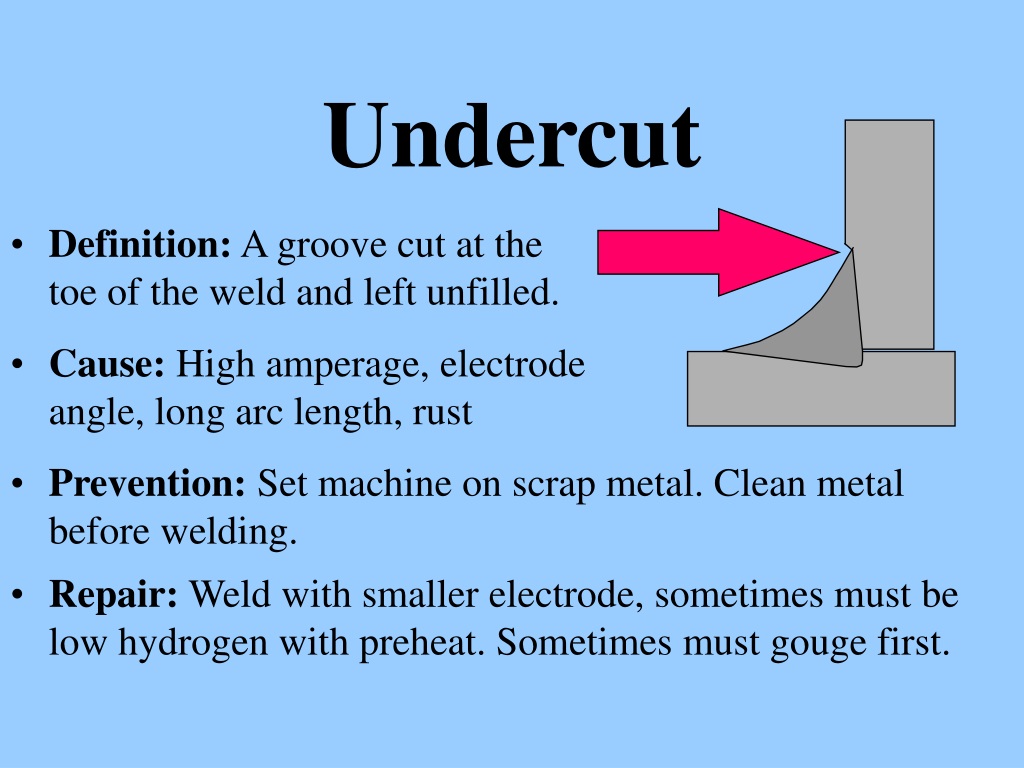Best Overview to Preventing Weld Undercut: Tips and Techniques
Best Overview to Preventing Weld Undercut: Tips and Techniques
Blog Article
Recognizing the Causes and Solutions for Undercut Welding in Steel Fabrication Processes
In the realm of metal manufacture processes, the occurrence of undercut welding positions a considerable challenge that demands an extensive understanding of its reasons and sensible solutions. The elaborate interplay of different aspects throughout welding operations can cause this undesirable phenomenon, affecting the structural integrity and general high quality of the welded joints - Preventing weld undercut. By dissecting the source of undercut welding and exploring effective restorative actions, producers can elevate the criterion of their craftsmanship and make certain the manufacturing of remarkable steel parts
Usual Reasons For Undercut Welding
Regularly forgotten in steel fabrication, undercut welding occurs due to different aspects that demand thorough attention and proficiency to be properly minimized. In addition, incorrect welding strategies, such as utilizing the incorrect welding angle or travel speed, can additionally contribute to damage formation. The option of welding parameters, such as voltage, existing, and cable feed speed, plays a considerable role in the event of undercut welding.
Influence of Incorrect Welding Parameters
Inaccurate welding parameters can substantially endanger the honesty and quality of welded joints in steel construction processes. The impact of inaccurate welding criteria shows up in various means, leading to structural weaknesses and problems in the bonded parts. One critical facet impacted by incorrect welding parameters is the infiltration depth of the weld. Insufficient heat input due to reduced welding currents or excessively high travel rates can result in inadequate combination in between the base metals, leading to insufficient joint penetration and weakened bonds. Alternatively, excessive heat input brought on by high welding currents or slow travel rates can result in burn-through and excessive reinforcement, creating a brittle and unstable weld structure. Furthermore, incorrect criteria such as incorrect voltage setups or wrong electrode angles can add to unpredictable weld bead accounts, lack of fusion, and raised possibilities of issues like damaging. Thorough focus to welding parameters is extremely important to make sure the manufacturing of top quality welds with the preferred mechanical buildings and architectural honesty.
Impact of Improper Torch Angle
Incorrect lantern angle in welding operations can dramatically influence the high quality and stability of the final weld joints in metal fabrication procedures. Undercutting is a typical welding problem where a groove creates along the weld toe, compromising the joint and compromising its structural honesty.
A lantern angle that is also steep can bring about insufficient penetration, insufficient blend, and enhanced spatter. On the other hand, a lantern angle that is as well shallow can lead to excessive penetration, burn-through, and distortion of the base material. Preventing weld undercut. Appropriate torch angle is important for ensuring constant weld high quality, toughness, and look
To stop damaging and various other defects brought on by incorrect torch angles, welders have to be trained to keep the proper torch angle throughout the welding process. Normal surveillance and modification of torch angles throughout welding can aid achieve audio welds with very little issues.
Duty of Inadequate Welding Techniques

One more facet of insufficient welding techniques is inappropriate weld prep work. Insufficient cleansing of the base steels, incorrect joint style, or inadequate edge prep work can all add to undercut welding. In addition, poor securing gas coverage or making use of the wrong sort of gas can cause incomplete blend and the development of undercut defects.
To resolve the role of inadequate welding methods in metal fabrication processes, it is vital to give extensive training for welders. Correct education and learning on welding criteria, joint prep work, and securing gas choice can help protect against undercut welding More Help and guarantee high-quality welds in steel construction projects.
Efficient Solutions for Undercut Welding
Dealing with undercut welding in steel fabrication look at here calls for implementing effective services to improve weld high quality and architectural honesty. Among the primary remedies to battle undercut is to adjust welding parameters such as voltage, present, and take a trip rate to guarantee correct warm input and combination. By fine-tuning these setups, welders can prevent extreme melting of the base metal and filler product, decreasing the possibility of undercut development.
Furthermore, appropriate joint preparation is crucial in preventing undercut. Ensuring tidy base steel surface areas complimentary of impurities and utilizing the appropriate bevel angle can aid promote better weld penetration and lower the threat of undercut - Preventing weld undercut. Utilizing suitable welding strategies, such as oscillating the lantern or weaving, can likewise aid in dispersing warm uniformly and filling up the weld joint appropriately, decreasing the opportunity of undercut issues
Furthermore, picking the right welding consumables, including electrodes and filler metals, is important in minimizing undercut. Utilizing materials with proper chemical compositions and mechanical properties can add to accomplishing sound welds with marginal undercut. Routine assessment and top quality control procedures should also be applied to find and resolve undercut problems quickly, ensuring the general integrity of fabricated metal parts.

Conclusion
In conclusion, visit this site right here understanding the reasons and remedies for undercut welding in metal fabrication processes is essential for accomplishing premium welds. By addressing common causes such as inaccurate welding criteria, improper lantern angle, and insufficient welding techniques, welders can protect against damaging and guarantee strong, durable welds. It is vital to take note of these variables and execute efficient remedies to enhance the overall welding process and end product top quality.

Report this page